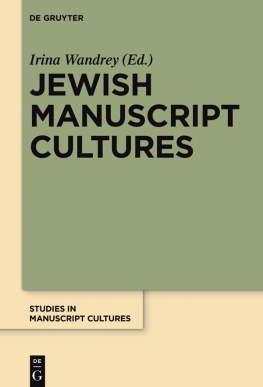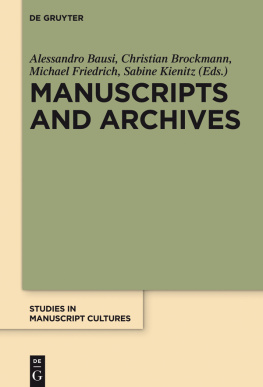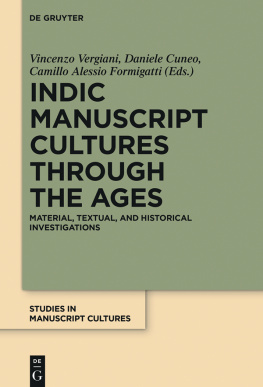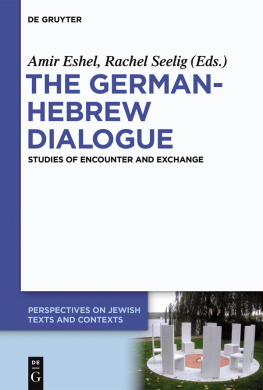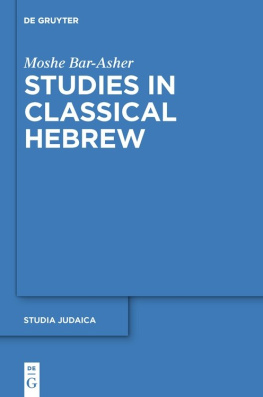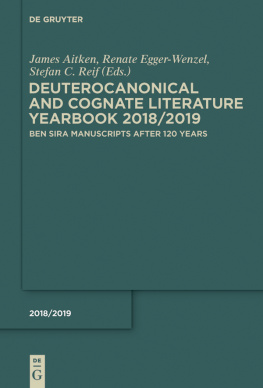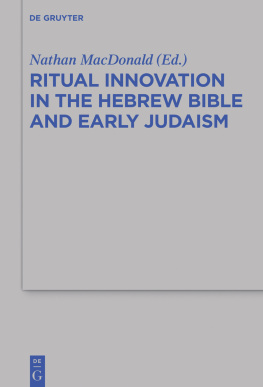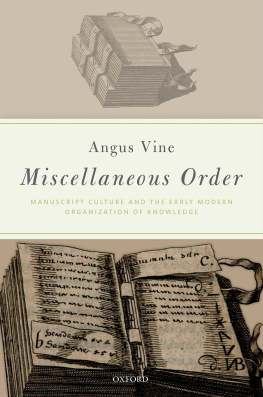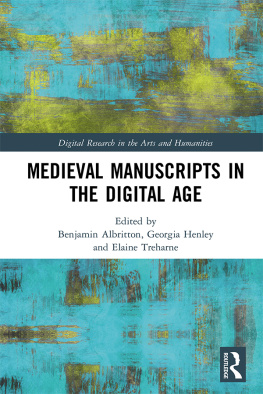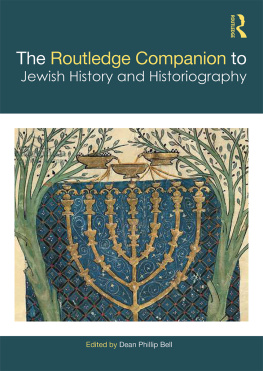Contents
Guide

Jewish Manuscript Cultures
Studies in Manuscript Cultures

Edited by
Michael Friedrich
Harunaga Isaacson
Jrg B. Quenzer
Volume 13

ISBN 978-3-11-054639-2
e-ISBN (PDF) 978-3-11-054642-2
e-ISBN (EPUB) 978-3-11-054654-5
ISSN 2365-9696

This work is licensed under the Creative Commons Attribution-NonCommercial-NoDerivs 3.0
License. For details go to http://creativecommons.org/licenses/by-nc-nd/3.0/.
Library of Congress Cataloging-in-Publication Data
A CIP catalog record for this book has been applied for at the Library of Congress.
Bibliographic information published by the Deutsche Nationalbibliothek
The Deutsche Nationalbibliothek lists this publication in the Deutsche Nationalbibliografie;
detailed bibliographic data are available on the Internet at http://dnb.dnb.de.
2017 Irina Wandrey, published by Walter de Gruyter GmbH, Berlin/Boston.
The book is published with open access at degruyter.com.
www.degruyter.com
Preface
Hebrew, Aramaic, Yiddish and Judaeo-Arabic manuscripts, part of the handwritten legacy of just four important Jewish languages, are considered to be invaluable documents and artefacts of Jewish culture and history. Looking back at an impressive history of modern scholarship starting with Leopold Zunz and Moritz Steinschneider in the 19 th century (among several others), it is evident that research on Jewish manuscripts has grown continually and is progressing particularly rapidly today.
In 1897, Moritz Steinschneider wrote the following in the introduction to his book Vorlesungen ber die Kunde hebrischer Handschriften, deren Sammlungen und Verzeichnisse :
Das Gebiet, das wir im Auge haben, ist gro und weit, und wollten wir zu Anfang ein kleines Bild aufrollen, so knnte es uns wie Mose ergehen, dass wir das gelobte Land schauen, aber nicht hineinkommen. (p. 1)
The area we are looking at is large and broad, and if we wanted to examine just a small part [of it] initially, we could easily find ourselves in the same situation as Moses, looking across the Promised Land, but not being able to enter it. (p. 1)
Steinschneider did enter this land, however, and so did numerous scholars after him (and still do today). The largesse and dazzling array of this land of the material and intellectual history of Jewish manuscript cultures from Antiquity to the Middle Ages and Early Modern Period continue to exert their fascination upon us today.
This volume is dedicated to the topics, methods and questions that are currently the focus of attention among the international scholars who are studying Jewish manuscripts. The case studies assembled here investigate paradigmatically subjects like cataloguing and editing, codicology and palaeography, manuscript forms and manufacturing techniques, patrons, collectors and censors, cultural exchange between Christians and Jews, manuscript collections and collections of printed books, illuminations and fragments of manuscripts, and, last but not least, new methods of material analysis that are now being applied to manuscripts.
In autumn 2014, a conference entitled Research on Hebrew Manuscripts: Status quaestionis took place at SFB 950 Manuskriptkulturen in Asien, Afrika und Europa/Centre for the Study of Manuscript Cultures (CSMC) at the University of Hamburg, generously funded by the German Research Foundation (DFG). It was jointly organised with the Institute for Jewish Philosophy and Religion, University of Hamburg. I would particularly like to thank its director Giuseppe Veltri for his part in this event. The present volume comprises sixteen of twenty-five papers read at the conference, in addition, Ingrid Kaufmann and Hanna Liss contributed articles. Those sixteen papers were classified into five subject areas: Codicology and Palaeography, Editing, Manuscript Collections, Materials Studies and Cultural Studies.
Codicology and Palaeography are covered in four of the contributions. A paper by Javier del Barco commences the volume by providing a critical historical appraisal of the tasks and purposes of cataloguing Hebrew manuscripts. The author goes beyond providing a mere description of the state of the art by outlining some new perspectives for classical codicology and palaeography based on two examples. These fundamental methodological reflections are followed up by three papers focusing on different groups of manuscripts that pose codicological, palaeographic and cultural questions. The outcomes of these studies establish new links between the local production of manuscripts, scribal characteristics and sociological parameters. In the first paper, Emanuel Tov looks at the scribal peculiarities and specific codicological characteristics of ancient scrolls found in the Judean Desert. Judith Olszowy-Schlanger then examines fragments found in the Cairo Geniza, presenting a new perspective on the use of the scroll and codex, two different forms of books used in Jewish communities in the Mediterranean Near East (Egypt, Palestine, Babylonia) in Late Antiquity and the Early Middle Ages. The article written by Hanna Liss is concerned with a mediaeval Ashkenazic manuscript known as the Regensburg Pentateuch , an exceptional document whose paratextual masora and tagin (decorative strokes on letters) refer to esoteric teachings of the German Pietists ( aside ashkenaz ).
The section on Editing is represented by two articles. Both of the authors, Diana Matut and Andreas Lehnardt, focus on questions concerning the editing of manuscript texts. While Andreas Lehnardt describes editing a binding fragment containing parts of an unknown mediaeval mystical text and consequently sheds some light on the esoteric tradition of the German Pietists in the process, Diana Matut delineates the history of interest in Yiddish manuscripts and texts, both among Christian and Jewish scholars, which led to early prints and the publishing of scholarly editions of Hebrew works. Both articles illuminate the tension and relationship between the manuscript as the support of a text on the one hand and the independent cultural artefact that a manuscript is on the other hand. They also illustrate the difficulty in doing both sides justice when editing a manuscript text.
In the following section, Collections, four contributions have been included that focus on Hebrew manuscripts owned by Christians, thereby opening up a history of persecution and destruction, but at the same time revealing a certain degree of intellectual collaboration between Jews and Christians. In between all the positive and negative encounters stand Jewish manuscripts objects of curiosity, of the thirst for knowledge and of fear and suspicion at the same time. Ilona Steimann discusses the pre-Reformation and humanist acquisition of Hebrew manuscripts by Christian collectors such as Hartmann Schedel, Petrus Nigri, Johannes Reuchlin and Caspar Amman, their motives for building collections and the ambivalence they showed towards the object they desired the Hebrew manuscript due to the basically negative attitude towards its producers and their scholarship. The humanist Johannes Reuchlin, who was a good deal more sympathetic towards Jews, his renowned collection of Hebrew books, which were scattered after his demise and have partly been lost since then, and its reconstruction are all subjects that Reimund Leicht addresses in his paper. Ronny Vollandt focuses on Jacob Georg Christian Adler, a scholar from Schleswig who studied Hebrew, Syriac and Arabic manuscripts and consequently became an early manuscript scholar and expert in Semitic languages. While investigating manuscripts and writing notes on them, he himself produced manuscripts documenting a history of scholarship worthy of research. Ilana Tahan had the aim of reconstructing the mysterious provenance of six Hebrew codices containing Kabbalistic, astronomical and philosophical texts that have belonged to the British Library ever since 1946. The trail she uncovers leads to Archbishop Jacques Nicolas Colbert to Bishop Charles de Pradel and to the Hebraist Jean Plantavit de la Pause a historical puzzle that has only partly been solved so far.

